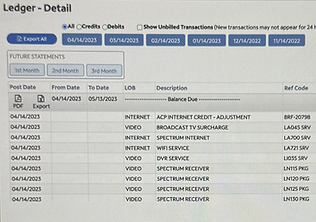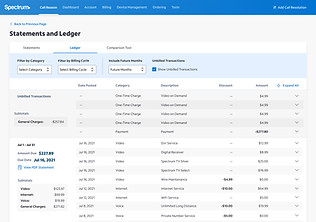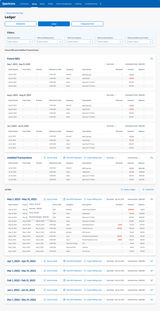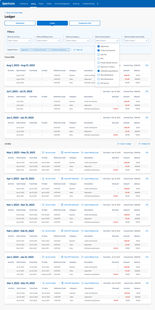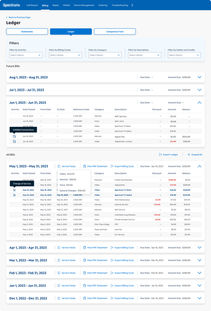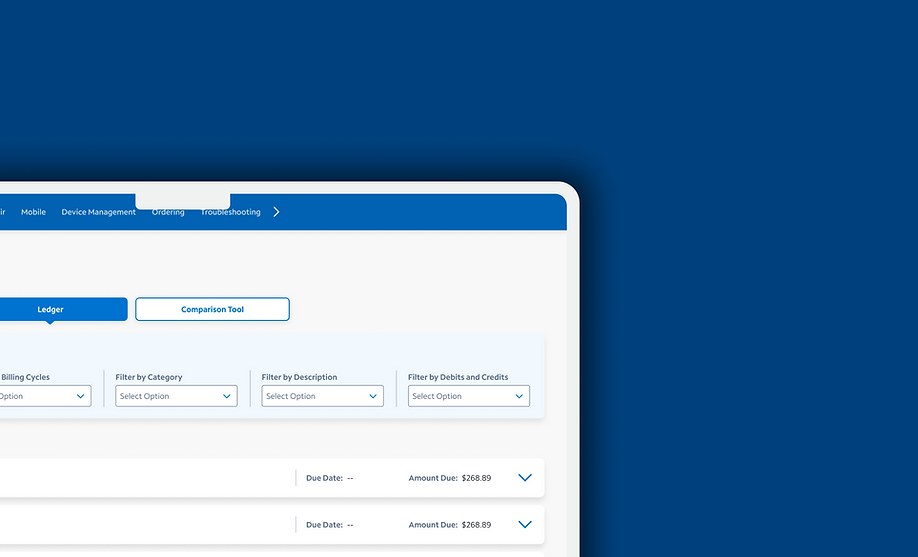
interactive Ledger
Ledger
Project Overview
Charter Communications’ internal Agent Tools web application housed multiple legacy ledgers for customer billing data. Each served a different purpose for various agent teams Billing, Retention, Ordering, and Mobile. Over the years, design inconsistencies and fragmented updates caused inefficiencies. Agents often had to jump between three separate ledgers to resolve a single customer issue, increasing average call times and lowering customer satisfaction. The project aimed to consolidate these three legacy ledgers into one cohesive, intuitive experience, empowering agents to access all necessary billing details in a single place.
3 existing ledgers
The agent tools platform included three existing ledgers, each reflecting a different stage of evolution in how billing information was presented and consumed by users.
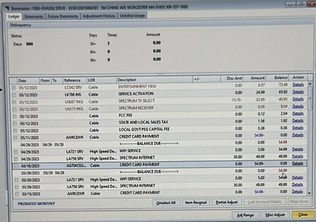
CSG Ledger
Original ledger
The original ledger used distinct color coding to help agents identify billing details at a glance: brown for service changes, red for balance due, and blue for payments. It also separated running balances and clearly marked new bill months, allowing multiple billing cycles to be viewed and compared simultaneously.
Role & Timeline
As the Lead Product Designer on the Billing Pod, I oversaw the full design effort, from discovery to final prototype testing while collaborating with a junior designer, content designer, and UX researcher. The main redesign phase took 2.5 weeks, with a major release in 2023 and incremental upgrades in 2024.
Problem
Agents were frustrated with the fragmented ledger system. Key data was distributed across multiple views, forcing agents to toggle between screens during live customer calls. This not only prolonged call times, but also caused confusion when comparing billing months or identifying service changes.
Key user pain points:
- Missing running balance visibility per billing month on a previously design ledger.
- Lack of “change of service” indicator, making it hard to quickly identify and explain new charges.
-
Overly spaced layouts that required excessive scrolling.
-
Inconsistent filtering and comparison tools between ledgers.
Goals
The project sought to create a “one-and-done” ledger experience, a unified interface that consolidated the best features from each legacy ledger.
User Goals:
Reduce cognitive load, simplify navigation, and access critical billing data faster.
Business Goals:
Reduce average call times and improve agent satisfaction scores across teams.
Design PRocess
The Agent Tools web app had evolved over decades, resulting in overlapping design paradigms and redundant systems. Our first step was conducting a comparative audit of all three ledgers, identifying strengths and weaknesses of each. In parallel, our UX research partner interviewed three distinct agent groups, uncovering why users were switching between ledgers during calls.
Key Research Insights
01
Insight
Agents relied on different ledgers for different information types.
02
Insight
The most popular ledger (CSG Ledger) offered tighter information density and better scannability.
03
Insight
Agents valued strong filtering tools and the ability to quickly compare billing months.
Ideation & Iteration
We synthesized these insights into design hypotheses, then began wireframing ideas. I led brainstorming sessions across pods (addressing a known pain point at Charter: limited cross-team design communication). Leveraging my prior experience on the Repair Pod, I focused the Billing pod to adapt existing Repair design patterns to maintain visual consistency across Agent Tools.
Prototype
Prototyping & Testing
Due to time constraints, we tested two high-fidelity design projects within one prototype in parallel. Both designs complemented each other and were able to cover one user scenario. Agent feedback was overwhelmingly positive, with 90% of testers asked how soon they could get access to the new design.
Results & Impact
First Rollout (2023)
-
Reached 50,000 call agents
-
75% positive feedback
-
Some technical constraints prevented inclusion of “change of service” data.

Second Rollout (2024)
-
Expanded to 150,000 agents
-
95% positive feedback
-
Marked decrease in median call times
-
Continuous collaboration with agents through follow-up surveys and feedback sessions
-
ensured long-term alignment.

Key Learnings
Legacy consolidation requires cultural change which can be improved by taking one step at a time. Starting with interpod communication had a critical and positive impact to the overall User Experience.
